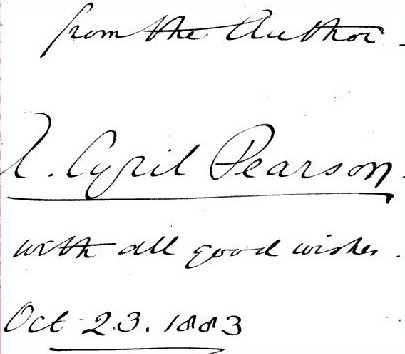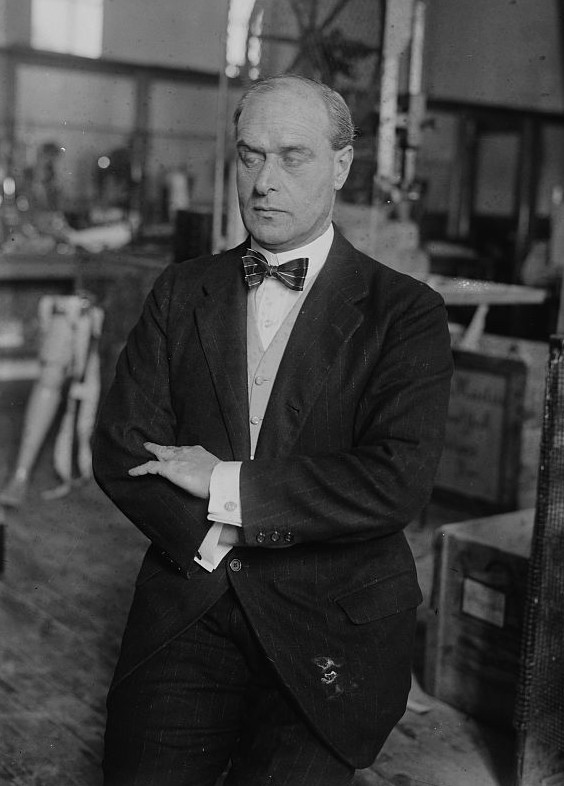The Pearson Family
Arthur Cyril Pearson

|
|
Rev. Arthur Cyril Pearson's signature
|
|
|
Reverend
9 January 1838, in Springfield,
Essex, England
at Springfield, Essex, England
Arthur Pearson, Rector in
Springfield, Essex, 1827-86
Sophia Jane Gepp
M.A. Balliol College, Oxford.
Matriculated 16 October 1856, aged 18, B.A. 1860, M.A. 1872
Philippa
Massingberg Maxwell-Lyte on 15 September 1864, in Guildford, Surrey,
England
Clergyman. Rector of Drayton
Parslow, Buckinghamshire from 1877 to 1886 and of Springfield, Essex,
following his father in 1886.
8 November 1916 in Hastings
district, Sussex, England, aged 79
Arthur wrote a book of chess puzzles
One Hundred Chess Problems first published
in 1878.
1878 (Dec): Drayton Parslow Rectory, Buckinghamshire (preface to One
Hundred Chess Problems)
1881: Rectory,
Drayton Parslow, Buckinghamshire
1883 (Apr): Drayton Parslow Rectory, Buckinghamshire (preface to 3rd ed. One Hundred Chess Problems)
Cyril Arthur Pearson
known as "Arthur"
 |
|
Sir Cyril Arthur Pearson (1918)
|
|
|
Sir Cyril Arthur Pearson, 1st
Baronet, GBE
24 February 1866, in Wookey,
Somerset, England
Arthur
Cyril
Pearson
Philippa
Massingberg (Maxwell-Lyte) Pearson
Isabel Sarah Bennett in
December 1887 in Amesbury
district, Wiltshire, England. Isabel was the daughter of Canon
Frederick Bennett, of Maddington, Wiltshire.
Ethel
Maud Fraser in 1897, in Hampstead
district, London, England. Ethel was born in 1870, in Hampstead
district, Middlesex, the daughter of William John Fraser.
Arthur started as a journalist,
working six years for George Newnes before leaving in 1890 to form his own
publishing business, creating the sucessful periodical Pearson's
Weekly. He built up a newspaper empire that included the Daily
Express, the Birmingham Daily Gazette
and the Evening Standard.
Arthur started to lose his eyesight due to glaucoma, and from 1910 onwards,
he began to divest himself from his newspaper interests and applied himself
and his considerable philanthropy to the blind. He became president of the
National Institute for the Blind in 1913, and in 1915 he founded St.
Dunstan's Hospital for those blinded in World War I, primarily by gas
attacks. This
letter was written by Pearson to the mother of a Canadian soldier
blinded in the war.
Pearson was an active writer, penning a number of tourist guides and, under
the nomme de plume Professor P R S Foli, he wrote books on fortune-telling,
and interpretation of dreams and handwriting. In 1919, Pearson wrote a
history of the St. Dunstan's home entitled Victory over Blindness. He corresponded and
shared Braille books with Helen Keller. In one letter she comments "I can
never thank you enough for the world of pleasure you have given me in these
twenty-two volumes. And all kinds of pleasure too, the soul-stirring witch
shades of The Dark Forest, the
delightful 'ill-written autobiography' of Joseph Vance, the galloping
narrative of Sherlock Holmes's adventures, the diplomat's diary, so rich in
the unworked ore of history. But above all I have your Victory
over Blindness in Braille. Reading it myself seems like feeling the
inspiration of your presence. How your words, passing under the finger-tips
of the blind, will pulse new hope and energy into them. Truly you are the
St. Dunstan of the sightless throughout the world."
9 December 1921, in St
Marylebone district, London, England, as a result of a fall in his
bath.
Hampstead Cemetery, West
Hampstead, London, England, The funeral was described in The
Star:
In little groups of twelve and twenty, blinded
men from every part of the kingdom, from Aberdeen and Penzance, from
Newcastle,
Bristol and Plymouth, came along to Hampstead Cemetery this morning to pay
final tribute to the man who was, above all others, their benefactor and
friend.
Never before had such a moving scene been witnessed at a public
funeral. It enhanced, if that were possible, the pathos of Sir Arthur's
tragic end.
They were brought to the cemetery in buses and motor-cars.
More than two hundred men of the Guards had volunteered to act as their
guides, and they helped the sightless men down from the top of the buses,
and then guided them gently to the graveside. There were many affecting
reunions of men who had fought side by side in the far-flung lines of the
war, who could recognise each other now only by the sound of voices that
had never been forgotten. Some of the blinded mourners carried wreaths and
bunches of flowers tributes they had brought with them from their homes on
behalf of those who were blind, even as they were.
In the cemetery itself and lining Fortune Green Road was a huge
concourse of people, numbering many thousands.
Men and women of reverent demeanour were there who had never seen
Sir Arthur, but who knew him as the man who had made life
easier for the similarly handicapped.
The service conducted at the graveside was similar to that being
held at Holy Trinity Church, Marylebone, and also at the Church of St.
Clement Danes, in the Strand.
Addressing the strange gathering, relieved in its sombre hue here
and there by the brighter uniforms of the Guardsmen, as 'Boys,' the Rev.
J. A. Williams, chaplain to St. Dunstan's, spoke a glowing eulogy of him
they had gathered to mourn.
As he began to repeat the opening prayer, every head was bared, and
there was not a movement among those who had come to hear, not to see.
With slightly bowed heads they remained in reverent attention. The
silence was intense.
Only the remote din of distant traffic broke, now and then, the
hush.
Then, led by the band of the 1st Grenadier Guards, the mourners
began the hymn 'Lead, kindly light.' At first the singing was faint,
voices were not responsive in the tensity of that moment, but gradually
the singing welled into mightiness as the crowd caught the tune, and to
the farthest fringes of the throng by the cemetery gates, this hymn of
ineffable pleading so strangely significant now rose to the heavens.
Not a word of the service was missed by the men, and when they sang
'Abide with Me,' and 'For all the Saints,' women wiped their eyes
unashamedly, and men turned away and looked across that God's acre through
the mist of tears.
The Blessing was pronounced by the Rev. J. A. Williams, and then,
scarce before the last words had died away, the mighty and the shuddering
opening chords of Chopin's 'Funeral March,' broke upon the congregation
with an almost startling suddenness.
Women sobbed aloud. Men were overcome.
It was a poignant episode in a service that had seemed always
poignant. A mountain of flowers had been sent to cover the grave.
There were gigantic wreaths and more humble floral tributes laid out in
long rows in a corner of the burial-ground.
Preceding the coffin, carried by a Boy Scout was an emblem in
flowers of the Union Jack, surmounted by a white dove and the device '
V.O.B.' the initial letters of the legend which has been made immortal by
the man who was being laid to rest, 'Victory over Blindness.'
1881:
Winchester College, Winchester, Hampshire
Ethel Pearson
1867, in Wookey, Somerset, England
Arthur Cyril
Pearson
Philippa
Massingberg (Maxwell-Lyte) Pearson
1881: Rectory,
Drayton Parslow, Buckinghamshire
- England Birth Index
(1Q1867 vol 5c p611); exact place from 1881 census
- 1881 census
Mabel Philippa (Pearson) Menzies
1868, in Wookey, Somerset, England
Arthur
Cyril Pearson
Philippa
Massingberg (Maxwell-Lyte) Pearson
Alfred Sydney Menzies in 1891 in Chelmsford
district, Essex, England. Alfred was born in 1858, in Winchester
district, Hampshire. He was vicar of Burley on the Hill, county
Rutland.
1881: Rectory,
Drayton Parslow, Buckinghamshire
Marion Pearson
1869/70, in Morden, Surrey, England
Arthur
Cyril Pearson
Philippa
Massingberg (Maxwell-Lyte) Pearson
1881: Rectory,
Drayton Parslow, Buckinghamshire
Marion Isobel Pearson
known as "Isla"
1889,
in Kingston
district, Surrey, England Cyril Arthur Pearson
Isabel Sarah (Bennett) Pearson
- England Birth Index
(2Q1889 vol 2a p308)
Muriel Pearson
Cyril
Arthur Pearson
Isabel Sarah (Bennett) Pearson
Neville Arthur Pearson
Sir Neville Arthur Pearson, 2nd
Baronet
13 February 1898, in Frensham,
Surrey, England
Cyril Arthur
Pearson
Ethel
Maud (Fraser) Pearson
Mary Angela Mond in 1922 in Chelsea
district, London, England. The Hon. Mary Angela Mond was the daughter
of the Minister of Health Alfred
Moritz Mond, 1st Baron Melchett.
The New York Times February 16 1922
ENGAGED
TO MARY MOND.
Sir
Neville Pearson to Wed Daugh-
ter of Minister of Health.
Special Cable to THE NEW
YORK TIMES.
LONDON, Feb. 15. - The engagement is
announced of Sir Neville Pearson, son of the late Sir Arthur Pearson,
and Mary Angela Mond, second daughter of Sir Alfred Mond, Minister of
Health.
-----
Sir Neville Pearson is 24 years old, and has visited this country
with his father, who became totally blind in 1912, and who died last
December. He served thirteen months on the Western front and was
wounded at Vimy Ridge. After the war he was his father's constant
companion. His father founded St. Dunstan's Hospital for Blind
Soldiers in London.
Gladys
Cooper in 1927.
Neville and Gladys divorced in 1936.
Milestones
in
Time Magazine, 21 September 1936
Sued for Divorce. British Actress Gladys Cooper; by Sir Neville
Pearson, publisher of Country Life; in London. Named corespondent was
Actor Philip Merivale, who was bedded with Actress Cooper in the opening
scene of last season's Manhattan dramatic success, Call It a Day.
from Milestones
in
Time Magazine, 10 May 1937
Married. Gladys Cooper, 45, British actress; and Actor Philip
Merivale, 50, with whom she is playing in Close Quarters; in Chicago, four
days after a final divorce was granted in London to her second husband,
Publisher Sir Neville Pearson (Country Life), who named Merivale as
corespondent.
Neville served for thirteen months on
the Western front in World War I, and was wounded at Vimy Ridge. He followed
in many of his father's footsteps, primarily as a publisher where he was
chairman at Newnes Publishing Company, and as Chairman of Arthur Pearson
Ltd. In 1947 he succeeded his mother as president of St. Dunstan's Hospital
for blind sailors and soldiers which his father had founded in 1915. In 1977
he left Britain for the United States.
6 November 1982, in Hightstown, New
Jersey, United States, aged 84. On his death, his baronetage became extinct.
The New York Times, 9 November 1982
SIR NEVILLE A. PEARSON
Published: November 9, 1982
Sir Neville Arthur Pearson, former chairman of Arthur Pearson Ltd., the
publisher of Country Life magazine and other publications in Britain, died
Saturday in Hightstown, N.J., where he had lived since leaving Britain in
1977. He was 84 years old.
The Pearson publications are now part of the International Publishing
Corporation of London. Sir Neville had a lifetime association with St.
Dunstan's, a London organization established in 1912 by his father, Sir
Arthur Pearson, to train and care for British servicemen and women blinded
in war. He had been president of St. Dunstan's and of Pearson's Fresh Air
Fund for poor children.
He is survived by three daughters, Shirley Gary, of Fair Haven, N.J.,
Sally Hardy, of Henley, England, and Lady Anne Glenkinglass, of London;
sixgrandchildren, and five great-grandchildren.
Nora Pearson
Cyril
Arthur Pearson
Isabel Sarah (Bennett) Pearson
Olive Noel (Pearson) Arnold
1871, in Morden, Surrey, England
Arthur
Cyril Pearson
Philippa
Massingberg (Maxwell-Lyte) Pearson
Harry
Holden Arnold in 1894, in Chelmsford
district, Essex, England
1881:
Rectory,
Drayton Parslow, Buckinghamshire
1919: 104 Queens Rd, Brighton, Sussex (manifest of the Carmania
on which her daughter Philippa arrived in New York)
- England Birth Index
(1Q1871 vol 2a p255); exact place from 1881 census
- 1881 census
- England Marriage Index
(3Q1894 vol 4a p669)
Return to Chris Gosnell's Home Page
If you have any comments, additions or modifications to the information on this page, please feel free to email me.
Created and maintained by: chris@ocotilloroad.com
